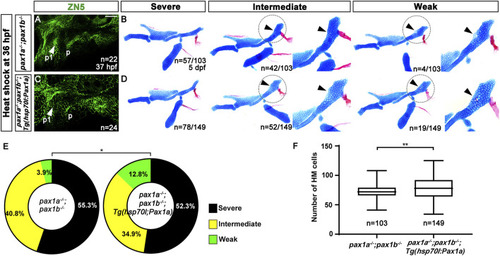
Rescue of the defects in the hyomandibular cartilage in pax1 double mutants with an enforced expression of pax1a at 36 hpf. (A, C) Zn5 immunohistochemistry to visualize pouches at 37 hpf. Arrowheads mark pouches. After the heat-shock treatment at 36 hpf for 40 min, pax1 double mutants display two pouches (p1 and p) with abnormal shapes (A), and pax1 double mutants carrying Tg(hsp70I:Pax1a) transgene show a distorted pouch (p), with the first pouch (p1) barely seen (C). Scale bar = 40 μM. (B, D) Lateral views of dissected facial skeletal elements of the mandibular and hyoid arches, along with inserts showing the zoomed-in HM plate (circled areas). After the heat shock treatment, the severe, intermediate, and weak defects in HM are seen in both pax1 double mutants and those bearing Tg(hsp70I:Pax1a) transgene. No wild-type HM plate is observed in (B, D). Cells appearing in the HM plate in the intermediate group and the mono-layered cells adjacent to the foramen in the weak group are indicated by arrowheads. (E) Quantification of the frequency of each group between (B, D). The frequency of each group is counted. Data is represented on a pie chart. Black, yellow, and green represent the severe, intermediate, and weak groups, respectively. * indicates p < 0.05. (F) Quantification of HM defects. The number of cells in HM is counted. Data is represented on a boxplot. ** indicates p < 0.01. n, number of animals analyzed.
|

